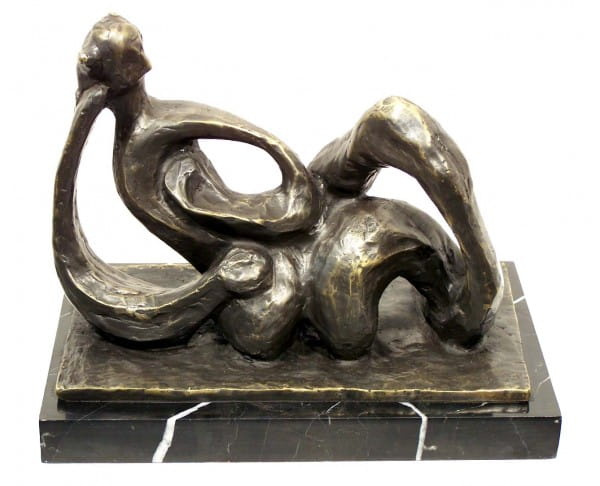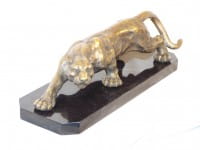€899.00 *
Prices incl. VAT, free shipping worldwide
Ready to ship today,
Delivery time appr. 3-6 workdays










The Birth of a Cubist Vision - Modern Art Sculpture - Signed Jacques Lipchitz In this moving... more
Product description
"Modern Art Statue - Jacques Lipchitz cubism - Bronze"
| Weight | 9 kg |
The Birth of a Cubist Vision - Modern Art Sculpture - Signed Jacques Lipchitz
In this moving modern Cubist sculpture by Jacques Lipchitz, the language of geometry becomes poetry in bronze. The work reflects the restless energy of early 20th-century Paris, yet achieves a timeless presence that transcends any individual movement. Angular surfaces intertwine with sweeping curves, inviting the eye to follow the changing facets of light and shadow. Lipchitz's mastery transforms cold metal into an ever-changing play of forms, with every angle revealing a new harmony amidst apparent fragmentation.
Forged in the Heart of Paris
The original model for this bronze was created in the spring of 1928 in Lipchitz's Montparnasse studio, at a time when the artist had fully realized his signature synthesis of Jacques Lipchitz Cubism and personal inventiveness. Working with a plaster model, he experimented with overlapping volumes—each surface a fragment of a larger, dynamic whole. The foundry in Seine-et-Oise captured his vision using the lost-wax casting process, preserving the crisp edges and subtle textures that reflect both the mechanical precision and the artisanal spontaneity of their creator.
From Vilnius to World Fame
Jacques Lipchitz was born on August 22, 1891, in Druskininkai, Lithuania. He came to Paris in 1909 to immerse himself in the avant-garde. He studied at the École des Beaux-Arts and became friends with Picasso, Braque, and the pioneering artistic circles around Jacques Lipchitz. By the mid-1910s, he had emerged as a leading voice of sculptural Cubism, translating the fragmentary vision of the canvas into three-dimensionality. His work reflected a modernity born of jazz rhythms, shifting cityscapes, and the excitement of creative revolutions.
Architecture of Movement
Here, the figure seems—suggestively, but never literally—caught in constant flux. Broad, faceted surfaces rise and fall like city rooftops; concave depressions hint at hidden chambers within the form. It is simultaneously static and kinetically charged, as if a breeze could shift a tilted shard and set the entire composition into a cascading metamorphosis. This tension between stillness and movement lies at the core of Lipchitz's vision and testifies to his ability to capture the dynamism of modern life in enduring bronze.
Technical Alchemy and Patina
After perfecting the wax model, Lipchitz oversaw the casting at a renowned Parisian foundry, choosing a bronze alloy prized for its fine grain and ability to retain sharp detail. After the initial polishing, he applied a rich, multi-layered patina—each coat of glaze darkened recesses and made raised edges shine like polished steel. The final seal ensures that the subtle color changes are preserved even after decades of display, giving the work a vibrant quality that evolves under changing lighting conditions and in changing atmospheres.
A Global Legacy in Bronze
By the time he moved to New York in 1941 to escape the turmoil of World War II, Lipchitz had already cemented his reputation as one of the most important sculptors of his time. His exploration of Jacques Lipchitz's Cubism left an indelible mark on public art, private collections, and museum holdings worldwide. This particular bronze is considered a masterpiece of this legacy, combining the intimate dimension of studio work with the magnificent scope of architectural form.
A Dialogue Between Generations
Whether placed in the foyer of a gallery or next to a modern facade, this sculpture facilitates a dialogue between past and present. Visitors are actively involved: they can walk around the sculpture, peer into intricate niches, and discover how each fragment fits into the unity of the whole. It is a work that rewards both close and distant observation, reflecting our enduring fascination with how form can reveal and simultaneously conceal the essence of things.
Enduring Power of Form
In this Modern Art – Cubism sculpture from Jacques Lipchitz, the visionary spirit of a master converges with the elemental beauty of bronze. No matter how many times the viewer returns, the sculpture offers fresh revelations: a subtle gleam here, a hidden angle there, the quiet echo of a Cubist manifesto inscribed in metal. It stands today as a monument to creative ambition, an ever-changing encounter with one of the 20th century’s most profound sculptural languages.
In this moving modern Cubist sculpture by Jacques Lipchitz, the language of geometry becomes poetry in bronze. The work reflects the restless energy of early 20th-century Paris, yet achieves a timeless presence that transcends any individual movement. Angular surfaces intertwine with sweeping curves, inviting the eye to follow the changing facets of light and shadow. Lipchitz's mastery transforms cold metal into an ever-changing play of forms, with every angle revealing a new harmony amidst apparent fragmentation.
Forged in the Heart of Paris
The original model for this bronze was created in the spring of 1928 in Lipchitz's Montparnasse studio, at a time when the artist had fully realized his signature synthesis of Jacques Lipchitz Cubism and personal inventiveness. Working with a plaster model, he experimented with overlapping volumes—each surface a fragment of a larger, dynamic whole. The foundry in Seine-et-Oise captured his vision using the lost-wax casting process, preserving the crisp edges and subtle textures that reflect both the mechanical precision and the artisanal spontaneity of their creator.
From Vilnius to World Fame
Jacques Lipchitz was born on August 22, 1891, in Druskininkai, Lithuania. He came to Paris in 1909 to immerse himself in the avant-garde. He studied at the École des Beaux-Arts and became friends with Picasso, Braque, and the pioneering artistic circles around Jacques Lipchitz. By the mid-1910s, he had emerged as a leading voice of sculptural Cubism, translating the fragmentary vision of the canvas into three-dimensionality. His work reflected a modernity born of jazz rhythms, shifting cityscapes, and the excitement of creative revolutions.
Architecture of Movement
Here, the figure seems—suggestively, but never literally—caught in constant flux. Broad, faceted surfaces rise and fall like city rooftops; concave depressions hint at hidden chambers within the form. It is simultaneously static and kinetically charged, as if a breeze could shift a tilted shard and set the entire composition into a cascading metamorphosis. This tension between stillness and movement lies at the core of Lipchitz's vision and testifies to his ability to capture the dynamism of modern life in enduring bronze.
Technical Alchemy and Patina
After perfecting the wax model, Lipchitz oversaw the casting at a renowned Parisian foundry, choosing a bronze alloy prized for its fine grain and ability to retain sharp detail. After the initial polishing, he applied a rich, multi-layered patina—each coat of glaze darkened recesses and made raised edges shine like polished steel. The final seal ensures that the subtle color changes are preserved even after decades of display, giving the work a vibrant quality that evolves under changing lighting conditions and in changing atmospheres.
A Global Legacy in Bronze
By the time he moved to New York in 1941 to escape the turmoil of World War II, Lipchitz had already cemented his reputation as one of the most important sculptors of his time. His exploration of Jacques Lipchitz's Cubism left an indelible mark on public art, private collections, and museum holdings worldwide. This particular bronze is considered a masterpiece of this legacy, combining the intimate dimension of studio work with the magnificent scope of architectural form.
A Dialogue Between Generations
Whether placed in the foyer of a gallery or next to a modern facade, this sculpture facilitates a dialogue between past and present. Visitors are actively involved: they can walk around the sculpture, peer into intricate niches, and discover how each fragment fits into the unity of the whole. It is a work that rewards both close and distant observation, reflecting our enduring fascination with how form can reveal and simultaneously conceal the essence of things.
Enduring Power of Form
In this Modern Art – Cubism sculpture from Jacques Lipchitz, the visionary spirit of a master converges with the elemental beauty of bronze. No matter how many times the viewer returns, the sculpture offers fresh revelations: a subtle gleam here, a hidden angle there, the quiet echo of a Cubist manifesto inscribed in metal. It stands today as a monument to creative ambition, an ever-changing encounter with one of the 20th century’s most profound sculptural languages.
Width: 31,5 cm
Height: 26 cm
Depth: 20 cm
Weight: 9 kg
100% Bronze
Related links to "Modern Art Statue - Jacques Lipchitz cubism - Bronze"
Read, write and discuss reviews... more
Customer evaluation for "Modern Art Statue - Jacques Lipchitz cubism - Bronze"
Write an evaluation
Evaluations will be activated after verification.
Our advantages
free shipping
Worldwide free shipping
14 days money back
You can cancel your order
within 14 days
secure payment services
Paypal, Master Card, Visa, American Express and more
NEW





















































